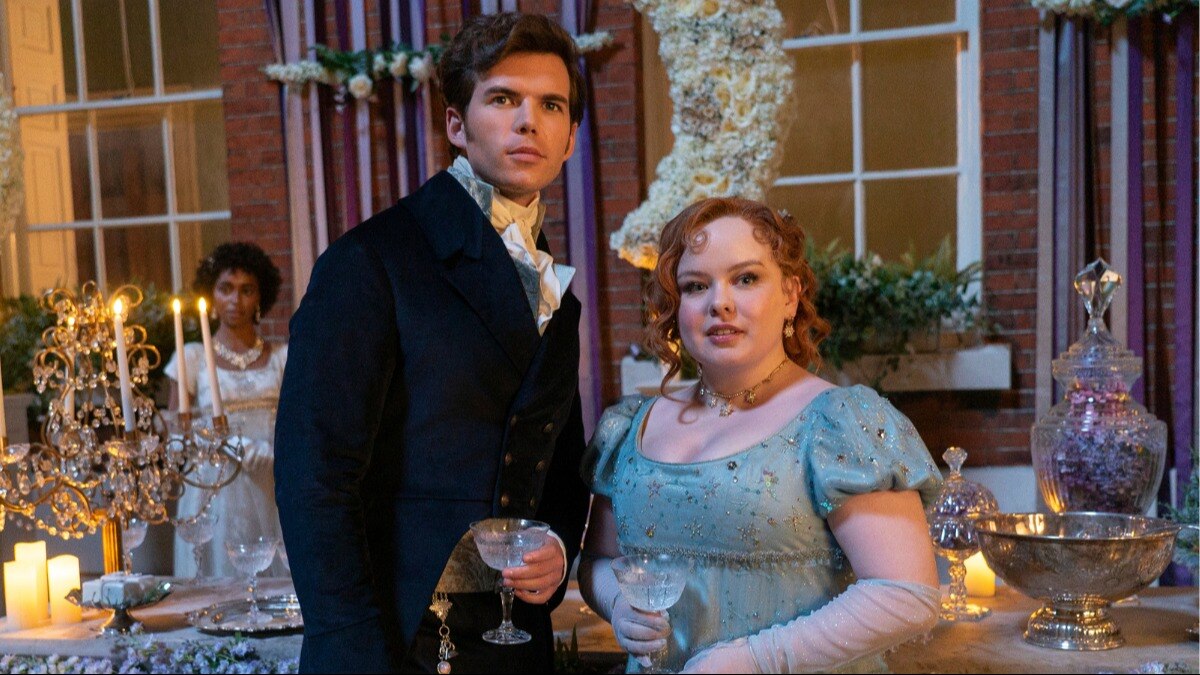
The complicated politics of queer rom-coms
The gay romantic comedy has become the next frontier in mainstream LGBTQ+ representation. But like many things in queer culture, people are divided over the extent to which this is truly radical.


At the very beginning of the new film Spoiler Alert, Michael (Jim Parsons) and Kit (Ben Aldridge) go on their very first date. Michael is asked what he was most obsessed with as a child, he responds instantly: “Christmas and soap operas!” As you may have gleaned from its title, the film—which was co-written by activist and writer Dan Savage and is based on the memoir by Michael Ausiello—doesn’t have a happy ending. But it still feels very much part of the romantic-comedy canon.
2022 has been the year of the gay rom-com. In June, Andrew Ahn’s Fire Island followed a group of friends who went on vacation to the gay hotspot. The film, which was loosely based on Jane Austen's Pride and Prejudice, was praised by critics and fans for exploring class dynamics in gay relationships, but also as a landmark moment in gay Asian representation. In September, Billy Eichner’s Bros was heralded as the first major studio release for a gay rom-com. The film was positively reviewed, but disappointed at the box office, which made it the Main Character in several weeks of social media discourse.
Gay rom-coms have become the next frontier in mainstream LGBTQ+ representation. But like many things in queer culture, people are divided over the extent to which this is radical, or even a good thing. In fact, this year’s gay rom-coms have reignited political debates which go right back to when LGBTQ+ people first started politically organizing together.
Romantic comedies often have a holiday-centric vibe to them. We all remember Renée Zellweger running through the snow in her knickers to find Colin Firth at the end of Bridget Jones’s Diary, or Cameron Diaz’s immaculate cashmere collection in The Holiday. The emotional final scene of 2001’s Serendipity (a personal favorite of mine) sees Kate Beckinsale and John Cusack reuniting on an ice rink as snow falls from the sky. Before streaming (AKA, the olden days) rom-coms were often released around the holiday season. And in the streaming era, they’re still the perfect way to spend a cozy winter evening (or wait for a festive hangover to subside).
Christmas is now a recurring character in queer rom-coms too. Last year, Netflix dropped Single All The Way—a cheap and cheerful Christmas film starring Michael Urie, Philemon Chambers and certified gay icon Jennifer Coolidge. Despite being a much sadder movie (like, seriously, it’s borderline traumatic), Spoiler Alert is the latest addition to the festive canon: the first time Michael and Kit feel like a “real couple” is when they first pose for a Christmas card together in their new apartment, before lying under the tree and fantasizing about their future. As we zoom through the years, Michael describes their relationship as “fourteen Christmas trees,” with one final Christmas together directly preceding the film’s tearful ending.

There is a distinctly gay love for Christmas and the culture that surrounds it. We can hear it in George Michael’s heartbreaking vocals on ‘Last Christmas’—recorded while he was still closeted—or the continued gay worship of the official queen of Christmas: Mariah Carey. It now feels like every pop star with a big gay following, from Ariana Grande to Kelly Clarkson and Kylie Minogue, has her own Christmas back-catalogue. In the U.K., where I’m from, pantomime dames (early-stage drag queens) have been a Christmas tradition for decades.
LGBTQ+ representation has also increased in festive films. There’s even a scene in Bros, shot at an NYC Christmas market, where Eichner satirizes the fact that every Hallmark movie seems to feature queer characters now. Netflix’s new wave of Hallmark-style Christmas films feel geared toward LGBTQ+ fans too—even when they don’t explore queer relationships. From Vanessa Hudgens repeatedly reprising her role in The Princess Switch and The Knight Before Christmas, to A Castle for Christmas starring Brooke Shields (with cameos from Drew Barrymore), or Lindsay Lohan in Falling for Christmas, many of these films seem tailor-made for a millennial gay audience.
What drives the gay love for the culture of Christmas? On an individual basis, there could be some baggage from childhood attached to it, which an overpriced shrink would have a field day unpacking. Looking more widely, though, I think it’s linked to long-lasting queer cultural trends. Growing up, my mother often described things as “camp as Christmas.” It’s a great expression, which I only came to fully understand in adulthood, when I realized just how gay the aesthetics and vibes of Christmas truly are. Christmas is the time of more-is-more, where looking cheap and garish is encouraged.

In queer culture there is a long tradition of gravitating towards art which, on the face of things, might seem “bad” or be interpreted as “low art”. This is visible on RuPaul’s Drag Race, where the “Rusical” challenges often look like they were pulled together on a shoe-string budget, or in the gay propensity for stanning artists whose music continually flops.
Why do queer people often celebrate art which is deemed “bad”? Academic definitions of both “camp” and “queerness” might help with unpacking this. Speaking in simplified and general terms, queerness and camp are not the same thing—but there is a connection between them. “While it's not true that camp taste is homosexual taste,” wrote Susan Sontag in her seminal 1964 essay Notes On “Camp”, “there is no doubt a particular affinity and overlap.” Academic definitions of “queer” aren’t restricted to its use as an identifier or umbrella term for people who are LGBTQ+. In fact, in this context, queerness is more often defined as a political force which is continually evolving to question our societal norms and conventions. Camp is thought to have a similarly reflexive quality: it repositions itself to mess with our existing notions of seriousness and humor.
Where mainstream LGBTQ+ representation goes, commercialization often follows.
Andy Warhol’s art occupied the part of the venn diagram where camp and queer overlap. In the 1960s, he struggled to be taken seriously by the avant-garde in New York’s art world. They deemed his work frivolous and kitsch, instead favoring more “serious” work by straight men like Jackson Pollock. Warhol always pushed back on this snobbery. “In some circles where very heavy people think they have very heavy brains, words like ‘charming’ and ‘clever’ and ‘pretty’ are all put-downs,” he wrote in 1975. “All the lighter things in life, which are the most important things, are put down.” When Warhol shaded “very heavy people,” he was likely referring to the “very straight” gatekeepers of taste in his own industry, who he eventually proved very wrong.
I wonder, then, whether queer people gravitating towards supposedly “low art” today—like cheap rom-coms or pop songs which totally bombed—could be interpreted as a rejection of mainstream and implicitly heterosexual standards of taste? Writing for Dazed on the trend for gay men stanning has-been pop stars, James Greig cites Jack Halberstam’s book, The Queer Art of Failure, which suggests that “failure can function as a subversive critique of capitalistic, heteronormative notions of success.” Halberstam writes that failure “is something queers do and have always done exceptionally well; for queers failure can be a style.”
In this context, flaunting a supposed lack of artistic taste could be read as an attempt at being disruptive. If resisting heteronormative conventions is inherent to queerness, then there can be a stigma against art which is seen as “assimilating” to these norms. In the book How to Be Gay, queer historian David Halperin describes an unease when gay culture becomes too aligned with mainstream straight culture. Halperin argues that gay men often reject representations of them in the public sphere—from fictional gay characters in TV shows to gay politicians—when they seem overly keen to appease the straight masses.
This was visible in the reaction to Bros. The film divided viewers to the point where there were think-pieces about the social media discourse. An overarching complaint was that the Bros was too conventional, or primarily made for straight audiences. Writing for the LA Times, Matt Brennan describes Bros as a missed opportunity to diverge from the standard rom-com format, where couples almost always end up together, with the presumption that they’ll get married and live happily ever after. “Ultimately, the film’s innovations are incremental,” he writes. “Rather than reinvent the genre around a different set of mores, it simply replaces the ‘marriage plot’ with the ‘monogamy plot.’”

Films like Bros, which position themselves as higher-quality than Hallmark-style movies, are more intensely scrutinized. The further we move away from films that are purposefully “bad”, then the reality that rom-coms aren’t a particularly radical artform comes into sharper focus. Here, there is a clash: some queer people argue there is a radicalism to LGBTQ+ representation in very mainstream spaces, like rom-coms and fuzzy Christmas films. But others are skeptical or dismissive of films which use queer characters to replicate fairly traditional relationship norms, or tropes like the “marriage plot”, which were invented by straight people, for straight people.
This is a microcosm of political arguments that have been fought within the LGBTQ+ community for decades. In the 1970s, the gay liberation movement argued that, rather than seek acceptance within capitalist systems and institutions like marriage, which they deemed oppressive and patriarchal, queer people should instead create their own structures. In 2022, books like The Transgender Issue and Bad Gays have made similarly liberationist arguments. The mainstream Pride movement ended up pursuing a different strategy: one of its central arguments has been that LGBTQ+ people are taxpayers, who are entitled to the same rights as everyone else in society who pays their way and obeys by the laws of the land. The idea of the “Pink Money” has been promoted in order to integrate LGBTQ+ people into society through consumerism. Greater representation and legal rights have been secured this way—within capitalism and institutions like marriage.
By now, we know that where mainstream LGBTQ+ representation goes, commercialization often follows. We see this at Pride parades with floats which are now sponsored by corporations. And on TV, where RuPaul’s Drag Race has become a money-making machine with its own conventions and merch—including, not uncoincidentally, RuPaul Christmas music and decorations. Netflix’s Queer Eye transformed its “Fab Five” into mega influencers with Paid Partnerships and endorsement deals. These are trade-offs that a lot of people are completely comfortable with, but they’re not celebrated by everyone.
Beneath its shiny, sparkly veneer, Christmas can be a time of tension. Not only between its two main religions: Christianity and capitalism, but within families and relationships too. And perhaps this makes rom-coms and the Christmas season the perfect cultural prism to explore the various conflicts of bringing queer art into the mainstream?
Some might assume rom-coms are a superficial artform devoid of any distinct politics. But whether it’s the enduring gay love for campy Christmas culture that revels in its tackiness, or the skepticism towards some of 2022’s supposedly “conventional” gay rom-coms, the debates surrounding these films are anything but apolitical.
Lead image credits: FOCUS FILMS
This piece originally appeared in Harper's Bazaar US.









